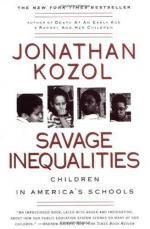
|
| Name: _________________________ | Period: ___________________ |
This test consists of 15 multiple choice questions and 5 short answer questions.
Multiple Choice Questions
1. What reason did the Post-Dispatch give for the evacuation of Martin Luther King Junior High School in the early spring of 1989?
(a) Fires in the kitchen.
(b) Lead in the drinking water.
(c) Sewage in the school.
(d) The emission of toxic chemicals.
2. In the chapter entitled "Life on the Mississippi," what office is described as the largest office in Illinois?
(a) The Welfare Office.
(b) The Lottery Office.
(c) The Unemployment Office.
(d) Health Services.
3. What are the major industries in Sauget besides the chemical plants?
(a) Funeral homes and car dealerships.
(b) Prison and cigarette manufacturers.
(c) Liquor stores and an outlet for the lottery.
(d) Topless joints and an outlet for the lottery.
4. How many years did Kozol spend visiting schools and speaking with children about their schools and neighborhoods?
(a) 2.
(b) 3.
(c) 4.
(d) 1.
5. In what year was the decision in Plessy v. Ferguson rendered?
(a) 1898.
(b) 1895.
(c) 1897.
(d) 1896.
6. In what year did Martin Luther King, Jr. live in North Lawndale?
(a) 1968.
(b) 1956.
(c) 1966.
(d) 1962.
7. What happened to Martin Luther King, Jr.'s home in Lawndale after he moved?
(a) It was bulldozed.
(b) It was sold to the city government.
(c) It was renovated by the new owner.
(d) It was declared a historical site.
8. How much money does Irl Soloman earn at East St. Louis High each year after teaching for nearly 30 years?
(a) $38,000.
(b) $32,000.
(c) $34,000.
(d) $36,000.
9. What public service does Kozol mention that East St. Louis lacks?
(a) Unemployment Services.
(b) Recycling.
(c) Trash Removal.
(d) Welfare.
10. What does Kozol say lottery proceeds go towards?
(a) State revenue.
(b) Education.
(c) Welfare.
(d) State health system.
11. How did Carla Hawkins, the teacher of a combination fifth and sixth grade class, acquire all the materials and resources for her class?
(a) The principal bought them for her.
(b) Another teacher loaned them to her.
(c) The school board provided her with funding.
(d) She bought them herself.
12. What court decision found that segregated institutions for black people could exist as long as they were equal to those open to white people?
(a) Davis, et. al. v. County School Board of Prince Edward County, VA et al.
(b) Briggs, et. al. v. Elliott et al.
(c) Plessy v. Ferguson.
(d) Brown v. Board of Education.
13. What system of schools does Kozol say are highly attractive to more sophisticated parents, who are disproportionately white and middle class?
(a) The urban school system.
(b) The magnet school system.
(c) The suburban school system.
(d) The charter school system.
14. How much money does Kozol say is spent on each child attending a poor, non-white, public school around Chicago?
(a) $7,000.
(b) $6,000.
(c) $5,000.
(d) $4,000.
15. How many banks did the Tribune say were located in North Lawndale?
(a) 3.
(b) 2.
(c) 1.
(d) 0.
Short Answer Questions
1. What is the population of the town of Sauget?
2. Approximately how many neighborhoods did Kozol visit?
3. How many housing units are in the Villa Griffin homes?
4. Who authored the poem that one of the most embittered students in Kozol's class memorized?
5. How much money does Irl Soloman say he would earn by teaching one of the schools in the suburbs of St. Louis?
|
This section contains 471 words (approx. 2 pages at 300 words per page) |

|




